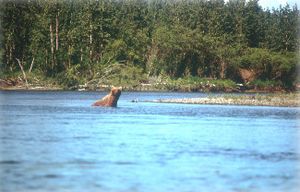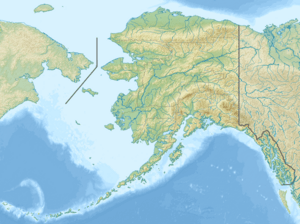Andreafsky River facts for kids
Quick facts for kids Andreafsky River |
|
|---|---|

Andreafsky River
|
|
|
Location of the mouth of the Andreafsky River in Alaska
|
|
| Native name | Negeqliq |
| Country | United States |
| State | Alaska |
| Census Area | Nome, Kusilvak |
| Physical characteristics | |
| Main source | Yukon Delta National Wildlife Refuge Iprugalet Mountain, Nome Census Area 1,487 ft (453 m) 63°08′27″N 161°42′37″W / 63.14083°N 161.71028°W |
| River mouth | Yukon River Pitkas Point, near St. Mary's, Kusilvak Census Area 10 ft (3.0 m) 62°01′45″N 163°15′09″W / 62.02917°N 163.25250°W |
| Length | 120 mi (190 km) |
| Type: | Wild |
| Designated: | December 2, 1980 |
The Andreafsky River is a cool river in Alaska, a state in the United States. Its name in the local Yup'ik language is Negeqliq, which means "Northern one." This river is about 120-mile (190 km) long.
It starts near Iprugalet Mountain in the Yukon Delta National Wildlife Refuge. The Andreafsky River flows south. It eventually joins the much larger Yukon River near a place called Pitkas Point. This area is close to the village of St. Mary's.
A Special River: Wild and Scenic
In 1980, the Andreafsky River became part of the National Wild and Scenic Rivers System. This means it's a very special river. It is protected to keep its natural beauty and wildlife safe.
The designation covers the main Andreafsky River. It also includes its East Fork. Together, these rivers and their starting points are protected for about 265 miles (426 kilometers). A big part of this protected area, about 198 miles (319 kilometers), flows through a wilderness area. Other parts cross private lands or special refuge areas.
Plants and Animals
The land around the Andreafsky River is full of interesting plants. You can find black spruce and white spruce trees. There are also balsam poplar trees. Large bogs, which are like marshy wetlands, are common.
At higher places, on the tundra, you'll see different plants. These include willow shrubs, mosses, and lichens.
Many animals live near the river. You might spot foxes and beavers. Birds like bald eagles, golden eagles, falcons, hawks, and owls fly overhead. Geese are also common. There are also many brown bears in the area.
One special bird, the Bristle-thighed curlew, nests here. This is one of their main nesting spots in the world. In the rivers themselves, you can find different types of fish. These include grayling, various kinds of salmon, and Dolly Varden trout.
Boating Adventures
The Andreafsky River is a great place for boating. You can use small rafts, folding canoes, or kayaks. About 105 miles (169 km) of the Andreafsky River is good for these boats. Its East Fork is also suitable for about 122 miles (196 km).
Both rivers are rated Class I (easy). This means they are calm and simple to navigate. However, reaching the starting points on the upper rivers can be tricky. You might need to hire a boat from St. Mary's. Or you could take an air taxi that lands on gravel bars.
One important thing to remember is that brown bears live here. So, it's important to be careful and aware of your surroundings.
The rivers are usually frozen for a long time. They don't become ice-free until June 1 or even later. After that, the water levels change. They are high in June, then get lower in July. By mid-August, they rise again. You can usually float on the rivers throughout September.


